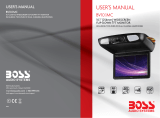If you notice problems, such as skipping, with the playback quality of your CDs or DVDs, try cleaning the discs.
1. Hold the disc by its outer edge. You can also touch the inside edge of the center hole.
2. With a soft, lint-free cloth, gently wipe the bottom of the disc (the unlabeled side) in a straight line from the center to the outer edge of the disc.
For stubborn dirt, try using water or a diluted solution of water and mild soap. You can also purchase commercial products that clean discs and provide
some protection from dust, fingerprints, and scratches. Cleaning products for CDs are safe to use on DVDs.
DellHardwareWarrantySupportPolicy(U.S.Only)
Technician-assisted support requires the cooperation and participation of the customer in the troubleshooting process and provides for restoration of the
operating system, software programs, and hardware drivers to the original default configuration as shipped from Dell, as well as the verification of appropriate
functionality of the computer and all Dell-installed hardware. In addition to this technician-assisted support, online support is available at support.dell.com.
Additional support options may be available for purchase.
Dell provides limited support for the computer and any "Dell-installed" software and peripherals
1
. Support for third-party software and peripherals is provided
by the original manufacturer, including those purchased and/or installed through Dell Software and Peripherals, Readyware, and Custom Factory Integration
2
.
1
Repair services are provided pursuant to the terms and conditions of your limited warranty and any optional support service contract purchased with the
computer.
2
All Dell-standard components included in a Custom Factory Integration (CFI) project are covered by the standard Dell limited warranty for your computer.
However, Dell also extends a parts replacement program to cover all nonstandard, third-party hardware components integrated through CFI for the duration
of the computer's service contract.
Definition of "Dell-Installed" Software and Peripherals
Dell-installed software includes the operating system and some of the software programs that are installed on the computer during the manufacturing process
(Microsoft
®
Office, Norton Antivirus, and so on).
Dell-installed peripherals include any internal expansion cards, or Dell-branded module bay or PC Card accessories. In addition, any Dell-branded monitors,
keyboards, mice, speakers, microphones for telephonic modems, docking stations/port replicators, networking products, and all associated cabling are
included.
Definition of "Third-Party" Software and Peripherals
Third-party software and peripherals include any peripheral, accessory, or software program sold by Dell not under the Dell brand (printers, scanners,
cameras, games, and so on). Support for all third-party software and peripherals is provided by the original manufacturer of the product.
FCC Notices (U.S. Only)
MostDellcomputersystemsareclassifiedbytheFederalCommunicationsCommission(FCC)asClassBdigitaldevices.Todeterminewhichclassification
applies to your computer system, examine all FCC registration labels located on the bottom, side, or back panel of your computer, on card-mounting brackets,
andonthecardsthemselves.IfanyoneofthelabelscarriesaClassArating,yourentiresystemisconsideredtobeaClassAdigitaldevice.Ifall labels carry
an FCC Class B rating as distinguished by either an FCC ID number or the FCC logo, ( ), your system is considered to be a Class B digital device.
Once you have determined your system's FCC classification, read the appropriate FCC notice. Note that FCC regulations provide that changes or modifications
not expressly approved by Dell could void your authority to operate this equipment.
This device complies with Part 15 of the FCC Rules. Operation is subject to the following two conditions:
1. This device may not cause harmful interference.
2. This device must accept any interference received, including interference that may cause undesired operation.
Class A
This equipment has been tested and found to comply with the limits for a Class A digital device pursuant to Part 15 of the FCC Rules. These limits are designed
to provide reasonable protection against harmful interference when the equipment is operated in a commercial environment. This equipment generates, uses,
and can radiate radio frequency energy and, if not installed and used in accordance with the manufacturer's instruction manual, may cause harmful
interference with radio communications. Operation of this equipment in a residential area is likely to cause harmful interference, in which case you will be
required to correct the interference at your own expense.






















